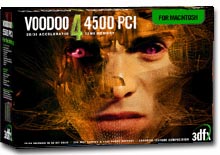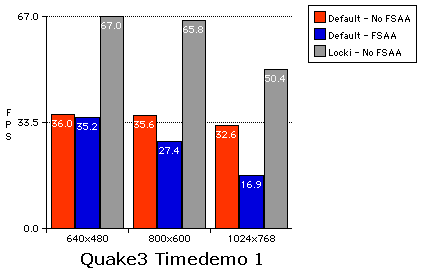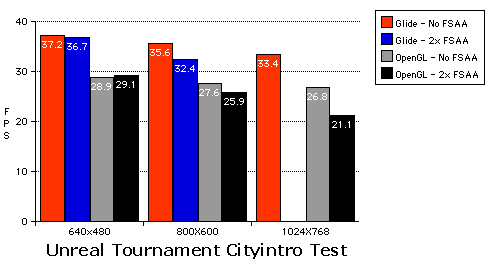 |
|

Review: 3dfx Mac Voodoo4 4500 PCI Graphics Card |
|
|
|
|
|
|
|
| Game Performance, FSAA and Image Quality | |
|
Of course, for many, the real measure of a card's 3D performance is how fast D games run. To measure game performance with the Voodoo4, I conducted timedemo tests with the retail versions of two of today's most demanding games: Quake III and Unreal Tournament. I also did more subjective testing with other games, such as Diablo II, Rainbow 6, and Tomb Raider: The Last Revelation. Visual Quality: Overall, game performance was excellent with the Voodoo4. Games were fluid and playable even at 1024x768 resolution. Diablo II in particular played much more smoothly than with the stock Rage 128 card (which often caused intense action to stop and stutter). In addition, Glide-based, Open GL, and RAVE games all launched and played without major problems. However, I noticed one odd tendency: Even if a game supported RAVE rendering in addition to Glide or OpenGL, it was sometimes impossible to choose RAVE mode. This was true of both Diablo II and Unreal Tournament. This isn't a big problem, as Glide and Open GL both offer good performance. In addition, RAVE-only games like Bugdom launched and played just fine. [Note: if the game supports Glide or OpenGL, use that rather than RAVE mode with the 3dfx cards, based on what I've seen with the Voodoo5. I consider RAVE mode a last resort for gaming on 3dfx cards with the current drivers at least.-Mike] Like performance, visual quality in games was generally good. A few rendering artifacts marred Tomb Raider: The Last Revelation, and image quality seemed unusually poor in Rainbow 6 compared to other games. Of course, it's possible these errors might be fixed with later driver releases. A more significant problem was that many games had a noticeable orange tint. This was especially apparent for backgrounds and textures that were supposed to be gray; instead they had a rusty, reddish appearance. While this didn't affect playability, it's certainly not the way the designers of these games intended them to look.
It was particularly interesting to test FSAA (fullscreen anti-aliasing), as this is one of the main features of the Voodoo4/5 family that 3dfx has been touting. While the Voodoo5 supports up to 4x FSAA, the Voodoo4 only supports 2x FSAA. However, even 2x FSAA produced noticeable--and pleasing effects--in many games. FSAA was particularly beneficial to less frantic games like Tomb Raider: The Last Revelation and Diablo II, giving graphics a smoother and more realistic look. In contrast, FSAA was less noticeable in fast-paced shooters like Quake III and Unreal Tournament. In addition, since enabling FSAA can reduce performance, playability of these hardware-intensive games can degrade when FSAA is turned on, especially at higher resolutions. That means it's probably best to turn FSAA off in games like Quake III and Unreal Tournament. However, for less demanding games like Tomb Raider: The Last Revelation, FSAA doesn't noticeably degrades performance while at the same time it helps create a more immersive look. This makes turning FSAA on a good idea for such games.
For those who like hard numbers, the graphs below show timedemo fps (frames per second) results for Quake III and Unreal Tournament. For all game tests, the system was rebooted with only base extensions (plus 3dfx extensions) turned on.
I tested Quake III v1.17 with 128MB of RAM allocated to the application. I first tested using Quake's default settings with FSAA off and on. Then I tested it again using the locki.cfg config file, which optimizes Quake III for maximum performance at the expense of visual quality. Because there was virtually no performance difference between 16-bit and 32-bit color settings (less than 3% at most), only the 32-bit results are reported below. Longer bars are better.  There are several interesting trends in these results. First of all, with FSAA turned off, performance is nearly identical across all resolutions. This is likely because the games are limited by the processing power of the Mac rather than the card. Turning on 2x FSAA tests the card a little better. Interestingly, there's virtually no performance hit at 640x480 when using FSAA. There's a moderate hit at 800x600, and a large hit at 1024x768. With a game like Quake III, you're better off disabling FSAA and playing at a higher resolution. The locki.cfg results show that you can get framerates over 60 fps with the Voodoo4. That's fairly impressive, but since 30fps is usually considered playable, its possible to play Quake III at a high resolution with high-quality settings. Comparing the results of these tests to the results for the Voodoo5 in Mike's review might raise some eyebrows. The Voodoo4 is in many cases slightly faster than a Voodoo5 in a blue and white G3/400. If one takes away the small difference in speed of the two G3s, it looks like the performance of the Voodoo4 and Voodoo5 are nearly identical--at least at lower resolutions. However, at 1024x768 (and at 800x600 with 2x FSAA enabled), the Voodoo5 starts to show an edge over the Voodoo4, suggesting that at these settings the Voodoo4 is starting to get saturated with data. So, for Quake III at least, the Voodoo5 seems to offer better performance only at higher resolutions: 1024x768, or 800x600 with 2x FSAA enabled. At lower resolutions, the Voodoo4 does just as well.
I tested Unreal Tournament v425a with 150MB of RAM allocated to the application. I used the same settings Mike did in his Voodoo5 review: low sound quality, medium texture quality, and minimum fps set to zero. I tested using both Glide (16-bit) and OpenGL (32-bit) rendering, with 2x FSAA disabled and enabled. Again, longer bars are better.
 Results were similar to those for Quake III. With FSAA turned off, performance was very similar across resolutions. Enabling 2x FSAA caused no performance hit at 640x480 and a small hit at 800x600. FSAA would not operate in Glide mode at 1024x768, but in OpenGL mode, it caused only a moderate hit--not as dramatic as in Quake III at this resolution. In general, Glide mode was about 25% faster than OpenGL mode, making it the API of choice for Unreal Tournament. How do these numbers compare to the Voodoo5? In Mike's review, one of the systems the Voodoo5 was tested in was a blue and white G3/450--the same as my test system. As in Quake III, at 640x480, the Voodoo4 offers nearly identical performance to the Voodoo5. Mike didn't test higher resolutions in Unreal Tournament, but my guess is the same pattern would apply here as in Quake III, with the Voodoo5 pulling ahead at higher resolutions. (The next page covers installation comments and info on the card and its software controls.) |
|
|
|
|
|
Intro | 2D Performance | 3D Performance | Game Performance | Installation | Summary - or - |
|
|
Copyright © 2000. All brand or product names mentioned here are properties of their respective companies.
|